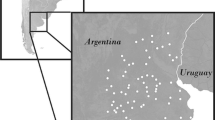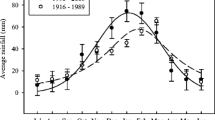Abstract
Determining soil nutrient distribution in pasture with beef cattle operation is critical to identifying which area is at risk of nitrogen or phosphorus buildup and loading. Characterizing spatial variability of soil nutrients in relations to landscape location is important for understanding the effects of future land use change on soil nutrients and water pollution. We hypothesized that cattle congregation site may have higher concentrations of phosphorus and nitrogen than in the pasture and grazing site or the adjoining forest site. This study assessed levels of Mehlich-1 extractable P, total inorganic N, and soil P saturation in relation to landscape locations in subtropical beef cattle pasture. Soil samples were collected during the spring and fall of 2005 to 2007 from three 19 adjoining landscape sites that are associated with beef cattle operation. These sites consisted of three locations: congregation, grazing, and forest sites. The levels of extractable P, total inorganic N, and P saturation in soils varied with landscape location. Congregation site had the highest concentration of extractable P of 36.1 mg kg−1, followed by grazing site of 17.7 mg kg−1, and forest site of 8.2 mg kg−1. Spatial distribution of total inorganic nitrogen across the landscape was higher for congregation site (2.3 mg kg−1) than forest site (0.9 mg kg−1) and grazing site (0.7 mg kg−1). The overall spatial distribution of extractable P from congregation site to forest site can be described by P = −4.2x + 45.8; (R 2 = 0.97**); the best-fit models for total inorganic N was 0.04x 2 − 0.6x + 3.5; (R 2 = 0.89**) and for soil P saturation was −3.6x + 36.2; (R 2 = 0.92**). Results show that the levels of extractable P, total inorganic nitrogen, and soil phosphorus saturation were decreasing from the congregation site to forest site. Although our results may have had supported our hypothesis that congregation site typical on Florida ranchers have greater concentrations of extractable P than in grazing site and forest site, the average extractable P at all three landscape locations did not exceed the crop requirement threshold of 36 mg kg−1 and the water quality protection threshold of 150 mg kg−1. Our current pasture management including cattle rotation in terms of grazing days and current fertilizer application had thus no negative environmental impact on landscape with cow–calf operation.




Similar content being viewed by others
References
Bilbrough CJ, Caldwell MM (1997) Exploitation of springtime ephemeral N pulses by six Great Basin plant species. Ecology 78:231–243
Blake GR, Hartge KH (1986) Bulk density-core method. In: Klute A (ed) Methods of soil analysis, Part 1, 2nd ed. Agronomy Monograph 9. American Society of Agronomy, Madison, pp 363–375
Brubaker SC, Jones AJ, Lewis DT, Frank K (1993) Soil properties associated with landscape positions. Soil Sci Soc Am J 57:235–239
Canham CD, Papaik MJ, Latty EF (2001) Interspecific variation in susceptibility to windthrow as a function of tree size and storm severity for northern temperate tree species. Can J For Res 31:1–10
Coble DW, Milner KS, Marshal JD (2001) Above- and below-ground production of trees and other vegetation on contrasting aspects in western Montana. Forest Ecol Manag 42:231–241
Foster DR, Aber JD, Melillo JM, Bowden RD, Bazzaz FA (1977) Forest response to disturbance and anthropogenic stress. Bioscience 47:437–445
Franzluebbers AF, Stuedemann JA, Schomberg HH (2000) Spatial distribution of soil carbon and nitrogen pools under grazed tall fescue. Soil Sci Soc Am J 64:635–639
Fu B, Ma K, Zhou H, Wang J (1999) The effect of land use structure on the distribution of soil conditions in the hilly area of the loess plateau, China. Chin Sci Bull 44:732–736
Ganskopp D (2001) Manipulating cattle distribution with salt and water in large arid-land pastures: a GPS/GIS assessment. Appl Anim Behav Sci 73:251–262
Gee GW, Bauder JW (1986) Particle size analysis. In: Klute A (ed) Methods of soil analysis, Part 1, 2nd ed. Agronomy Monograph 9. American Society of Agronomy, Madison, pp 377–381
Gough MW, Marrs RH (1990) A comparison of soil fertility between semi-natural and agricultural plant communities: implications for the creation of species-rich grassland on abandoned agricultural land. Biol Conserv 51:83–96
Gregorich ED, Carter MR, Angers DA, Monreal CM, Hellert BH (1994) Towards a minimum data set to assess soil organic matter quality in agricultural soils. Can J Soil Sci 74:855–862
Heckrath GP, Brookes C, Poulton PR, Goulding KWT (1995) Phosphorus leaching from soils containing different phosphorus concentrations in the Broadbalk experiment. J Environ Qual 24:904–910
Hodge A (2004) The plastic plant: root responses to heterogeneous supplies of nutrients. New Physiol 162:9–24
Holechek JL (1988) An approach for setting stocking rate. Rangeland 10:10–14
Holloway JD, Stork NE (1991) The dimension of biodiversity: the use of invertebrates as indicators of human impact. In: Hawksworth DL (ed) The biodiversity of microorganisms and invertebrates: its role in sustainable agriculture. CAB International, Wallingford, pp 37–63
Hontoria C, Rodriguez-Murillo JC, Saa A (1999) Relationships between soil organic carbon and site characteristics in Peninsular Spain. Soil Sci Soc Am J 63:614–621
Hooda PS, Rendell AR, Edwards CC, Withers PJ, Aitken MN, Truesdale VW (2000) Relating soil phosphorus indices to potential releases to water. J Environ Qual 29:1166–1171
Hutchings MJ, John EA, Wijesinghe DK (2003) Toward understanding the consequences of soil heterogeneity for plant populations and communities. Ecology 84:2322–2334
Hyde AG, Law L Jr, Weatherspoon RL, Cheney MD, Eckenrode JJ (1977) Soil Survey of Hernando County, FL. USDA-NRCS, Washington, DC and University of Florida, Gainesville, p 152
Jackson LE, Schimel JP, Firestone MK (1989) Short-term partitioning of ammonium and nitrate between plants and microbes in an annual grassland. Soil Biol Biogeochem 21:409–415
Kleb HR, Wilson SD (1997) Vegetation effects on soil resource heterogeneity in prairie and forest. Am Nat 150:283–298
Kuo S (1996) Phosphorus. In: Sparks DL et al (eds) Methods of soil analysis. Part 3. Chemical method. SSSA Book Series No.5. SSSA, Madison, pp 869–919
Lepsch IF, Menk JRF, Oliveira JB (1994) Carbon storage and other properties of soils under agriculture and natural vegetation in Sao Paulo State, Brazil. Soil Use Manag 10:34–42
Maguire RO, Sims JT, Foy RH (2001) Long term kinetics for phosphorus sorption–desorption by high phosphorus soils from Ireland and the Delmarva Peninsula. USA Soil Sci 166:557–565
Manley JT, Schuman GE, Reeder JD, Hart RH (1995) Rangeland soil carbon and nitrogen responses to grazing. J Soil Water Conserv 50:294–298
Martin SC, Ward DE (1973) Salt and meal-salt help distribute cattle use on semi-desert range. J Range Manage 26:94–97
Mehlich A (1953) Determination of P, Ca, Mg, K, Na, and NH4. North Carolina Soil Test Division, Mimeo, Raleigh
Moar EL, Wilson SD (2006) Root responses to nutrient patches in grassland and forest. Plant Ecol 184:157–162
Mulvaney RL (1986) Nitrogen-inorganic forms. In: Sparks DL et al (eds) Methods of soil analysis. Part 3. Chemical method. SSSA Book Series No. 5. SSSA, Madison, pp 1123–1185
Nelson DW, Sommers LE (1996) Total carbon, organic carbon, and organic matter. In: Sparks DL et al (eds) Methods of soil analysis. Part 3. Chemical method. SSSA Book Series No.5. SSSA, Madison, pp 961–1011
Odum EP (1969) The strategy of ecosystem development. Science 164:262–270
Partel M, Wilson SD (2002) Root dynamics and spatial pattern in prairie and forest. Ecology 83:1199–1203
Penn CJ, Mullins GL, Zelazny LW (2005) Mineralogy in relation to phosphorus sorption and dissolved phosphorus losses in runoff. Soil Sci Soc Am J 69:1532–1540
Pregitzer KS, Hendrick RL, Fogel R (1993) The demography of fine roots in responses to patches of water and nitrogen. New Phytol 125:575–580
Saviozzi A, Levi-Minzi R, Cardelli R, Riffaldi R (2001) A comparison of soil quality in adjacent cultivated, forest and native grassland soils. Plant Soil 233:251–259
Schlesinger WH, Raikes JA, Hartley AE, Cross AF (1996) On the spatial pattern of soil pattern of soil nutrients in dessert ecosystems. Ecology 77:364–374
Schuman GE, Reeder JD, Manley TJ, Hart RH, Manley WH (1999) Impact of grazing management on the carbon and nitrogen balance of mixed grass rangeland. Ecol Appl 9:65–71
Senft RL, Rittenhouse LR, Woodmanse RG (1985) Factors influencing patterns of cattle grazing behavior on shortgrass steppe. J Range Manage 38:82–87
Sigua GC, Coleman SW (2007) Sustainable management of nutrients in forage-based pasture soils: effect of animal congregation sites. J Soil Sediments 6:249–253
Sigua GC, Coleman SW (2010) Spatial distribution of soil carbon in pastures with cow-calf operation: effects of slope aspect and slope position. J Soils Sediments 10:240–247
Sigua GC, Coleman SW, Albano J (2009) Quantifying soil organic carbon in forage-based cow-calf congregation-grazing zone interface. Nutr Cycl Agroecosyst 85:215–223
Sigua GC, Hubbard RK, Coleman SW, Williams M (2010) Nitrogen in soils, plants, surface water and shallow groundwater in a bahiagrass pasture of Southern Florida, USA. Nutr Cycl Agroecosyst 86:175–187
Sigua GC, Myer RO, Coleman SW, Mackowiak C, Adjei M, Chase CC, Albano J (2011a) Regional distribution of soil phosphorus across congregation-grazing zones of forage-based pastures with cow-calf operations in Florida. J Environ Prot 2:408–417
Sigua GC, Coleman SW, Albano J, Williams M (2011b) Spatial distribution of soil phosphorus and herbage mass in beef cattle pastures: effects of slope aspect and slope position. Nutr Cycl Agroecosyst 89:59–70
Smilauerova M (2001) Plant root response to heterogeneity of soil resources: effects of nutrient patches, AM symbiosis, and species composition. Folia Geobotanica 36:337–351
Statistical Analysis System (2000) SAS/STAT User’s Guide. Release 6.03. SAS Institute, Cary, p 494
Sumner ME, Miller WP (1996) Cation exchange capacity and exchange coefficients. In: Sparks DL et al (eds) Methods of soil analysis. Part 3. Chemical method. SSSA Book Series No.5. SSSA, Madison, pp 1201–1231
Thomas W (1996) Soil pH and Soil Acidity. In: Sparks DL et al (eds) Methods of soil analysis. Part 3. Chemical method. SSSA Book Series No.5. SSSA, Madison, pp 475–491
Wang J, Fu B, Qui Y, Chen L (2001) Soil nutrients in relation to land use and landscape position in the semi-arid small catchment on the loess plateau in China. J Arid Environ 48:357–550
Watt AS (1947) Pattern and process in the plant community. J Ecol 35:1–22
White SL, Sheffield RE, Washburn SP, King LD, Green TJ Jr (2001) Spatial and time distribution of dairy cattle excreta in an intensive pasture system. J Environ Qual 30:2180–2187
Author information
Authors and Affiliations
Corresponding author
About this article
Cite this article
Sigua, G.C., Coleman, S.W., Chase, C.C. et al. Absence of negative environmental effects of increased soil P levels in cattle congregation zones. Agron. Sustain. Dev. 32, 693–701 (2012). https://doi.org/10.1007/s13593-011-0066-5
Accepted:
Published:
Issue Date:
DOI: https://doi.org/10.1007/s13593-011-0066-5




